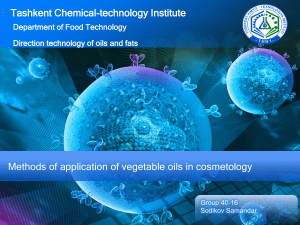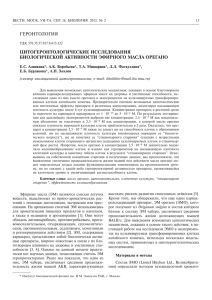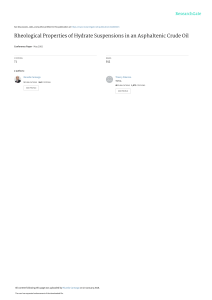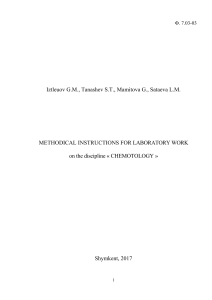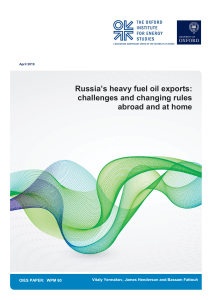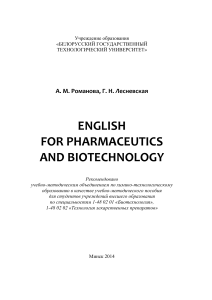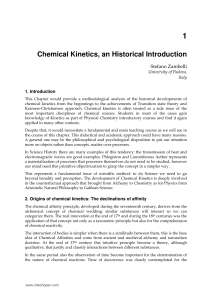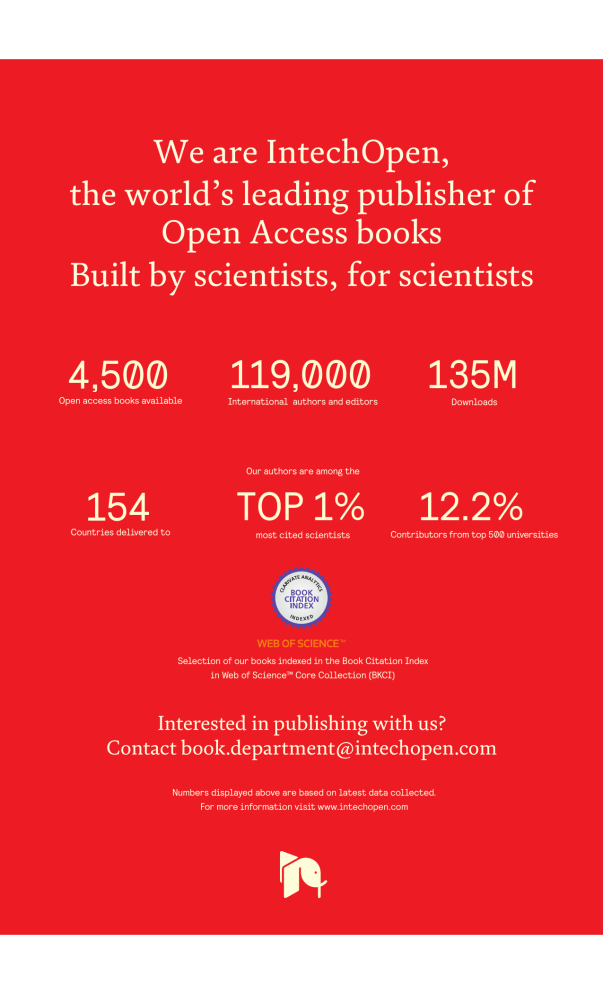
We are IntechOpen, the world’s leading publisher of Open Access books Built by scientists, for scientists 4,500 119,000 135M Open access books available International authors and editors Downloads Our authors are among the 154 TOP 1% 12.2% Countries delivered to most cited scientists Contributors from top 500 universities Selection of our books indexed in the Book Citation Index in Web of Science™ Core Collection (BKCI) Interested in publishing with us? Contact [email protected] Numbers displayed above are based on latest data collected. For more information visit www.intechopen.com Chapter Introductory Chapter: Heavy Crude Oil Processing - An Overview Ramasamy Marappa Gounder 1. Introduction The demand for crude oil as an energy source is continuously increasing driven by the ever-growing population and economic development. Globally, over 80 million barrels per day of crude oil is produced currently out of which about 11 million barrels are classified as heavy crude oils. It has been well recognized that reservoirs of light conventional crude oils are decreasing and heavy crude oils are replacing them in the pool of crude oil feedstock in refineries which process the crude oils into various value-added products such as gasoline, diesel, liquefied petroleum gas, petrochemical feedstock, etc. The contribution of heavy crude oils in the crude oil pool is predicted to increase over the years from the current ~10%. An oil industry expert, Professor Emeritus Peter Odell, suggested that by 2100, the oil industry will be larger than in 2000 but up to 90% dependent on unconventional crude oils (high-acid crude oils, heavy crude oils, bitumen, and oil sand) [1]. Heavy crude oil reserves are proven to be abundant, and the active heavy oil-producing countries include Canada, Venezuela, United States, Mexico, Brazil, Russia, Indonesia, China, Colombia, Ecuador, Iraq, Kuwait, Saudi Arabia, Chad, and Angola. Heavy oils are relatively cheaper than light conventional crude oils, and, therefore, they present an economic opportunity to petroleum refiners to take advantage of their low cost to increase the refiner’s profit margins. Heavy crude oils represent an important energy resource and require an unusually high levels of effort and expertise to economically produce and process. But as the energy demands grow, the economics of heavy oil production and processing will improve. The production and processing of heavy oils will be influenced by the effectiveness of available technologies. Heavy crude oils are defined as any liquid petroleum with an API gravity in the range of 10–22.3° [2]. The fundamental characteristics of heavy crude oils are high viscosity and density, chemical complexity, high acidity, high sulfur, increased level of metal and heteroatom impurities, high asphaltenes content, low American Petroleum Institute (API) gravity, and low H/C ratio [3]. Due to these unfavorable characteristics, heavy crude oils are termed low-quality crude oils, and they pose many technological challenges in their production, transportation, and processing to both the producers and the refiners. Extracting and processing of heavy crude oil require large amounts of water and energy and can potentially cause extreme damages to surrounding environment. This chapter will provide an overview on the challenges posed by heavy crude oils due to their unfavorable characteristics. Extraction of heavy oils is presented in Section 2. Section 3 will discuss in the flow assurance issues due to the high viscosity 1 Processing of Heavy Crude Oils - Challenges and Opportunities of heavy crude oils and techniques. Section 3 discusses the technological challenges that are encountered while processing the heavy crude oils in the refineries. Section 4 provides a summary of the issues discussed in this chapter. These issues are dealt in more details in the subsequent chapters of the book. 2. Extraction Cold extraction and surface mining would be preferred for the recovery of heavy crude oils. However, as the depth of the reservoir increases, and due to the very high viscosities, recovery becomes extremely difficult. Water flooding becomes ineffective due to their huge differences in their viscosities. In order to increase the recovery factor, enhanced oil recovery methods are to be followed. As oil viscosity decreases with the increase of temperature, external thermal sources can be introduced to heat the oil and reduce the viscosity. Steam is generally used as a thermal source. Once the viscosity gets reduced, recovery techniques using chemicals and gases can be implemented to improve the displacement efficiency. Cyclic steam stimulation, steam flooding, steam assisted gravity drainage, in situ combustion, chemical injection, gas injection, and in situ catalytic upgrading are some of the typically applied methods to enhance the recovery of heavy crude oils. These methods require large volumes of water and energy on the wellheads to successfully implement. In situ catalytic recovery of heavy oil has many advantages over the steam, gas, and chemical injections. Milder operating conditions, reduced waste products with higher extend of upgrading, minimization of surface upgrading facilities, and reduced environmental impacts are some of the advantages [4]. 3. Flow assurance The viscosity of heavy crude oils is in the range of 100–10,000 cp, while the extra-heavy crude oils have viscosities greater than 10,000 cp. As the viscosity increases, flow characteristics of heavy crude oils dramatically change to very low mobility. The mobility of heavy crude oils reduces to such an extent that conventional pumping techniques fail to achieve any flow from the well bottom to the wellhead or in the transportation pipelines from the platforms to the receiving centers. In addition, wax and asphaltene depositions on the walls of the pipelines as temperature drops also hinder the flow through the pipelines. Such depositions can lead to multiphase flow, clogging of pipelines, high pressure drops, and occasional pipeline stoppages. Flow assurance is a technique through which the crude oil is transported from the wellbore to the processing facilities while mitigating all the risks and guaranteeing a manageable and profitable flow. The flow assurance techniques are generally classified into three approaches, namely, viscosity reduction, drag minimization, and in situ crude oil upgrading [5]. 3.1 Viscosity reduction techniques There are several methods in practice to reduce the viscosity of heavy crude oils in an effort to increase their mobility. These methods include (i) heating, (ii) dilution with light liquid hydrocarbons, (iii) oil-in-water emulsion formation, and (iv) depression of pour point [5, 6]. Heating is one of the common methods employed for pipeline transportation of heavy oils. Viscosity of heavy oils are highly dependent on temperature, and an increase in temperature produces a significant drop in viscosity. The pipelines are 2 Introductory Chapter: Heavy Crude Oil Processing - An Overview DOI: http://dx.doi.org/10.5772/intechopen.90425 generally well insulated, and the temperature is maintained by providing external heating. Thermal management of production and transportation pipelines is very important, and there are several approaches to provide external heat in the pipelines, e.g., bundled pipelines in which a heating fluid is circulated through a pipeline within a carrier pipe and electrically heated subsea pipelines. For high wax crude oils, in addition to thermal management through heating/insulation, chemical inhibitor injection also helps in reducing crystallization of wax and thus viscosity. Dilution is another method of reducing the viscosity of the heavy oil. It involves the addition of lighter liquid hydrocarbons such as condensates from natural gas production, conventional lighter crude oils, and product streams such as kerosene from the refinery. In some cases, up to 30 wt.% of kerosene is required to sufficiently reduce the viscosity. The disadvantage is that this uses up large quantities of valuable commercial products, and, moreover, the added product is to be processed again through the refinery along with the heavy crude oil. This, in turn, reduces the plant production capacity and at the same time reduces the plant energy efficiency. The addition of lighter liquid hydrocarbons may also affect the stability of wax and asphaltenes leading to pipeline clogging. Sometimes, the dilution is also necessary to meet the API requirements of the existing refineries. Emulsion of oil-in-water is an alternative to the method of dilution to reduce the viscosity of heavy oils. When the heavy oil is dispersed in water, the flow characteristics improve tremendously. However, additional substances such as surfactants or stabilizing agents are added to ensure the stability of the emulsions. Pour point depressants, also known as wax crystal modifiers, are the chemical additives that prevent nucleation and crystallization of paraffin. They reduce the viscosity and yield stress of the crude oil appreciably enabling the transportation of waxy crude oils. 3.2 Drag reduction techniques Developing a core annular flow of heavy oils with a thin film of water or an aqueous solution between the core and the wall of the pipe reduces the pressure drop due to friction in the pipeline. This is akin to lubricating the inner core of the heavy oils and thus reducing the pressure drops. But, it is quite difficult to maintain the stability of the core through the length of the commercial pipelines. 3.3 In situ crude oil upgrading Physicochemical upgrading of heavy oils produces a synthetic oil or syncrude with higher API gravity and low viscosity. Upgrading of crude oil involves in situ production of a solvent through separation, distillation, and thermal cracking, a part of the heavy oil to produce lighter fractions. The lighter fractions can be used to dilute the heavier fractions to upgrade their mobility. 4. Heavy crude oil refining The processing of heavy oils in refineries, especially in the existing refineries, presents many difficulties due to their unfavorable characteristics. Due to very low H/C ratios, the yields of straight-run gasoline, kerosene, and diesel are very poor due to high levels of heavier components such as asphaltenes. A major fraction of the heavy crude oil after fractionation in an atmospheric distillation column is expected to report to the residue stream as the feed to the vacuum distillation unit. 3 Processing of Heavy Crude Oils - Challenges and Opportunities The economic value of the residue stream is very low, and therefore, conversion techniques are required to upgrade them to maximize the production of valueadded streams. The upgrading of the residue streams is generally done in one of the two methods, namely, hydrogen addition (e.g., hydrotreating or hydrocracking) or carbon rejection (e.g., deasphalting, delayed coking, visbreaking, and thermal/ catalytic cracking) [7–9]. Fluidized catalytic cracking (FCC) and residue fluidized catalytic cracking (RFCC) convert heavy oils into more valuable gasoline and lighter products. These technologies enable the effective utilization of crude oils. FCC and RFCC process technologies have become the heart of modern refineries for upgrading heavy oils by upgrading atmospheric and vacuum residue streams. Refineries require a high flexibility in residue processing facilities like FCC and RFCC to cater to the highly varying nature of feedstocks. There are several operational difficulties that arise in these upgrading processes. For example, very high operating temperatures in the range of 500–1000°C in thermal cracking units favors extensive coking [7, 10]: large amounts of expensive solvents for separating high-molecular-weight components in solvent deasphalting with relatively low yields of recovered deasphalted oil [11]. Catalytic deactivation caused by coking and metals (e.g., Ni, V, Ca, and Fe) and requirements of expensive hydrogen are major drawbacks of the hydrogen addition methods [11]. Except the heavy oil reserves from Africa, the rest of the heavy oil reserves have been characterized to contain high levels of sulfur. Desulfurization is therefore necessary in order to (i) meet the fuel specifications on sulfur content (e.g., 10 ppm limits on gasoline and diesel according to Euro 5 standards) and (ii) to protect catalysts from getting poisoned by sulfur. Hydrotreating removes materials such as sulfur, nitrogen, and metals harmful to the catalysts, and hydrotreaters are required to be located before the reformer, hydrocracker, and FCC units. Heavy metals also poison the catalysts used for the conversion techniques mentioned above and, thus, makes it imperative to pretreat crude oils to remove the metal contaminants almost completely. Higher fractions of asphaltenes in crude oils contribute to heavy fouling in crude preheat train which affects the delicate balance of heat integration and stable operation of the atmospheric distillation column. Fouling is also pronounced with the presence of sulfur and naphthenic acid in the crude oil. High-acid crude oils require the removal of acid contents below certain threshold levels to safeguard the assets from corrosion effects. 5. Conclusion Heavy crude oils will steadily replace the conventional light crude oils as energy sources to meet the increasing energy demands. The characteristics of heavy oils render the existing extraction and refining processes ineffective. This chapter enlisted some of the technological challenges faced by the oil producers and refiners. Flow assurance is a much challenging issue in producing and transporting heavy crude oils. Due to the low quality of the crude oil, the refining processes face enormous challenges. Issues such as fouling, corrosion, excessive coking, catalyst poisoning, increased contaminants in end products, the requirement of large hydrogen resources, environmental pollutions, high operating and maintenance costs, etc. require to be addressed with adequate and effective technologies. The synthesis of new catalysts for refining processes which are tolerant to the impurities present in heavy oils is also very crucial for the improved economics of refineries. 4 Introductory Chapter: Heavy Crude Oil Processing - An Overview DOI: http://dx.doi.org/10.5772/intechopen.90425 Author details Ramasamy Marappa Gounder1,2 1 Department of Chemical Engineering, Universiti Teknologi PETRONAS, Seri Iskandar, Perak D.R, Malaysia 2 Centre for Process Systems Engineering, Institute of Autonomous Systems, Universiti Teknologi PETRONAS, Seri Iskandar, Perak D.R, Malaysia *Address all correspondence to: [email protected] © 2019 The Author(s). Licensee IntechOpen. Distributed under the terms of the Creative Commons Attribution - NonCommercial 4.0 License (https://creativecommons.org/ licenses/by-nc/4.0/), which permits use, distribution and reproduction for non-commercial purposes, provided the original is properly cited. 5 Processing of Heavy Crude Oils - Challenges and Opportunities References [1] Sperling D, Gordon D. Two Billion [10] Ebrahimi S, Moghaddas JS, Razavi Cars: Driving Towards Sustainability. Oxford, England, UK: Oxford University Press; 2009. p. 130 Aghjeh MK. Study on thermal cracking behavior of petroleum residue. Fuel. 2008;87:1623-1627 [2] Huc AY. Heavy Crude Oils: From [11] Speight J. Heavy and Extra-Heavy Geology to Upgrading: An Overview. Paris, France: Editions Technip; 2011 Oil Upgrading Technologies. 1st ed. UK: Gulf Professional Publishing; 2013 [3] He L, Lin F, Li X, Sui H, Xu Z. Interfacial sciences in unconventional petroleum production: From fundamentals to applications. Chemical Society Reviews. 2015;44:5446-5494 [4] Guo K, Li H, Yu Z. In-situ heavy and extra-heavy oil recovery: A review. Fuel. 2016;185:886-902 [5] Palou RM, Mosqueira ML, Rendón BZ, Juárez EM, Huicochea CB, Clavel-López JC, et al. Transportation of heavy and extra-heavy crude oil by pipeline: A review. Journal of Petroleum Science and Engineering. 2011;75:274-282 [6] Santos RG, Loh W, Bannwart AC, Trevisan OV. An overview of heavy oil properties and its recovery and transportation methods. Brazilian Journal of Chemical Engineering. 2014;31(3):571-590 [7] Rana MS, Samano V, Ancheyta J, Diaz J. A review of recent advances on process technologies for upgrading of heavy oils and residua. Fuel. 2007;86:1216-1231 [8] Khan MK, Kwek W, Kim J. Upgrading heavy crude oils and extra heavy fractions in supercritical methanol. Energy & Fuels. 2017;31:12054-12063 [9] Canıaz RO, Erkey C. Process intensification for heavy oil upgrading using supercritical water. Chemical Engineering Research and Design. 2014;92:1845-1863 6
